
If you're looking for screen-free games like Rock, Paper, Scissors (and other variations) then you've come to the right place! Games like these are simple and cooperative. Some of them work well with two people while others can be played by groups.
These rock, paper, scissor alternatives are a great way to spend time with friends or family while having some high-quality fun together! Also, kids can play them on their own with friends, once they know the rules.
Best of all, they give everyone a chance to win, while also learning that you can't win every time.
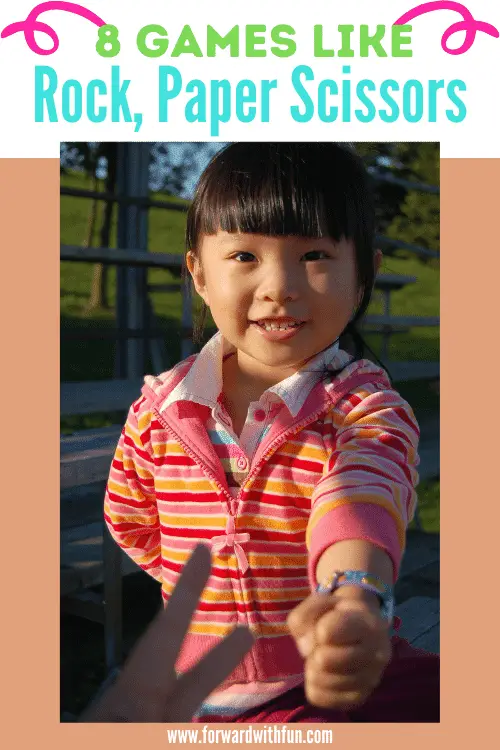
Two players start in spots a few feet away from each other, and a designated "safe spot" is chosen. The players play Rock Paper Scissors and whomever is the winner chases the other player, attempting to tag them before getting to the safe spot!
This is a great way to practice addition with kids in kindergarten and first grade as they're building fluency for math facts (which means they need to add small numbers fast). Instead of rock, paper, or scissors, children put up a number of fingers between 0-5. Whomever can yell out the sum of the two numbers first is the winner of that round! You can even make the sum their points and add up round after round.
My friend Erin of Erintriesparenting.com shows us how to play and build addition and one to one correspondence skills while waiting in the car.
Yes, that's a real game! It's a bit more complicated than rock paper scissors, but it works the same way. Players either choose one of the five hand signals: rock, paper, scissors, Spock, lizard.
Each signal kills/eliminates 2 other hand signals. For the full rules and hand signals you can check out this explanation.
This version was popularized by The Big Bang Theory but was developed by Sam Kass and Karen Bryla. Hand signals too complicated? You can use these dice!

This game had me feeling all the feelings when I first watched a PE lesson where children were playing. What a great group, team building activity.
Kids are divided into teams that need to navigate a hula hoop path, jumping from hoop to hoop. Whenever you encounter a person (coming the opposite way) you stop and play Rock, Paper, Scissors. Whomever wins continues on the path while the other team's player exits the path and a new team member starts again. It's easier to watch it, so check out this Youtube video!
Another common way to decide a quick "winner" is through arm or finger wars. You know the common adage, "1, 2, 3, 4, I declare a thumb war!" As two players grasp hands, whomever can keep the other player's thumb down for 5 seconds in the winner!
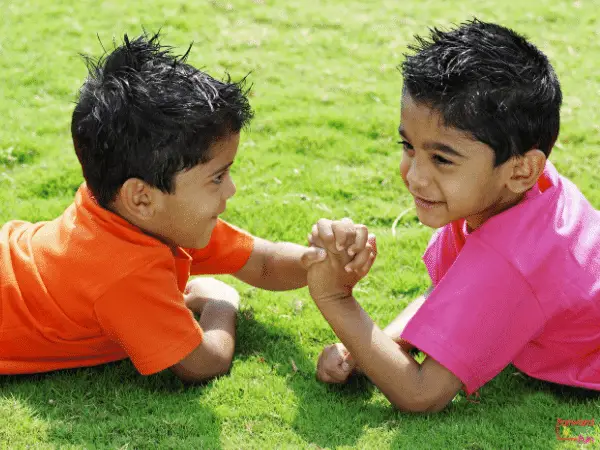
This one is similar to the eye contact game. Stare at the person in front of you and be as silly as you can but DO NOT, under any circumstances, laugh. The first one to laugh is the loser, but are they really? Laughing is the great medicine to many a bad mood.
Siblings have played this game since the dawn of time. Whomever can go the longest without blinking while staring at the other person is the winner. Get ready for red eyes, because IT'S ON!
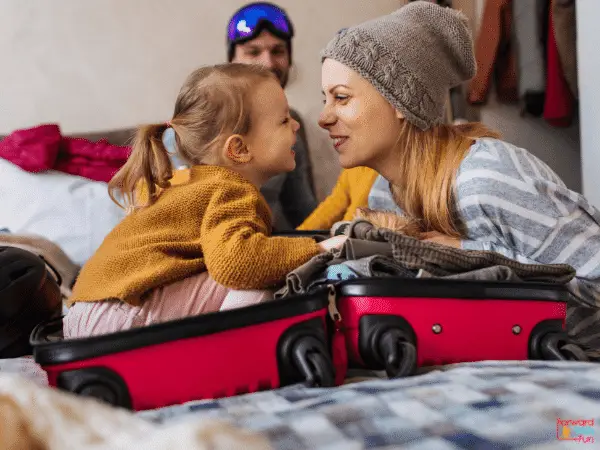
This one has a bit more thinking as part of it, but is a great two or more person game. First start with the rhythm "clap, clap, snap, snap" that everyone goes along with.
Think of a category and take turns saying things that are part of the category. For example: The category is articles of clothing. Go around in a circle (or if it's just two people, take turns) saying an article clothing to the rhythm of the clap, clap, snap, snap. If a player cannot say a new item that fits the category by the end of the two snaps, they're out!
- Games like these are cooperative so all the players need to follow the rules for them to work. This is great for children who are learning to follow multistep directions.
-They give kids multiple chances to win or lose and to deal with the emotions that come with that. We all know someone who can be a sore loser (ahem, my oldest), but losing more often can actually help us realize it's not a reflection of anything negative. There are so many chances to win too.
-They teach perseverance. Just because you didn't get it this time, doesn't mean you won't the next!
-Many of them require motor planning- which is the ability to plan and execute a sequence of actions in order to succeed at something. These types of games give kids practice with this important skill!
- Games like these require communication, so they build social skills too!
-They're fun ways to pass the time and connect with another person.
There is a major math skill that shows up when teaching kids how to separate laundry...SORTING!
Sorting helps our little ones discern differences and similarities, learn how to create categories, and begin to problem solve. Imagine how helpful sorting is in your everyday life.
You sort silverware, clothing, and toys all to create organized systems in your home. At the grocery store, items are sorted by categories for ease and efficiency of shopping. Recess at schools is most often sorted by grade level to keep kids of the same age together.
Sorting happens all the time, and kids need to know how to sort in more than one way in order to make sense of new information as they process the world around them. So let's teach these kiddos how to separate laundry before and after, and lighten your load while keeping them learning!

There are so many ways to separate laundry but for kids these are the main ones you'll want to focus on.
Before washing categories:
After washing categories:
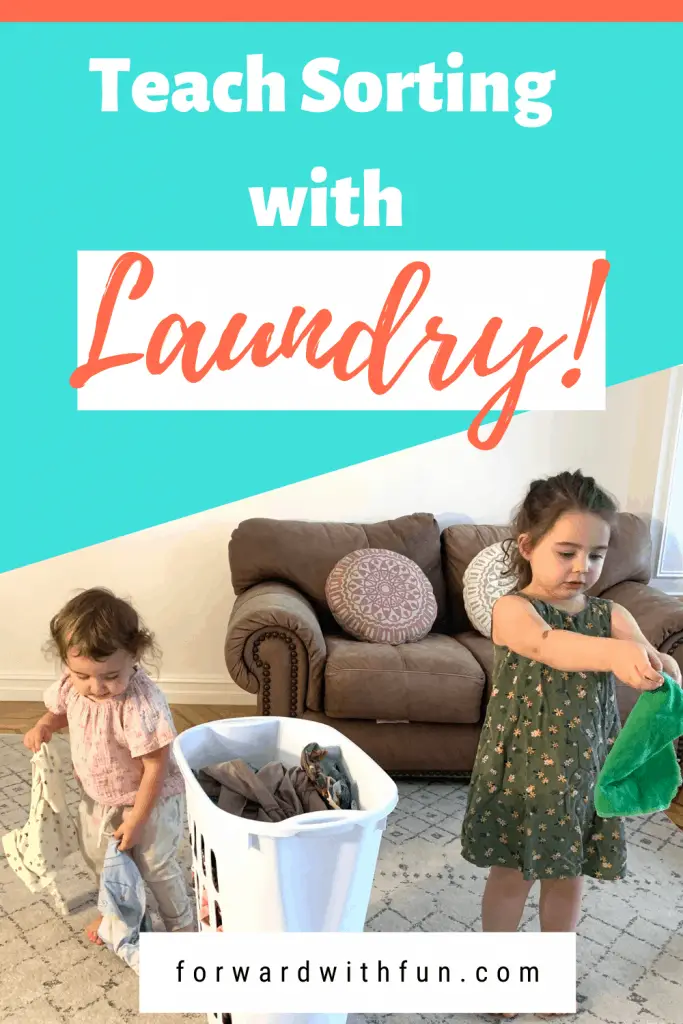
In kindergarten kids need to..."Classify objects into given categories; count the numbers of objects in each category and sort the categories by count." -Kindergarten Common Core Standards
This activity encourages your child to sort the same objects in more than one way. Also there are opportunities for you to ask your CHILD how they think they should sort and separate the laundry, both before and after washing.
Being able to sort the same group of objects in more than one way shows diversity in thinking. It also engages us to problem solve: What is the best way to sort? There may be more than one answer.
For example, it might be better for the clothes to be sorted before washing by color in order for color not to leak from brights to whites. But since I don't have enough whites on my own, I may have to combine all the sizes to run a load of whites. This will make it harder to sort the laundry afterwards by person!
Go the step further and asking your child to describe HOW they want to sort gives us insight into how our child views the world: Is the size of something a bigger factor than its function? Is it more helpful to do lights together instead of whites? How come? These are critical thinking skills!
I had a giant pile of clean laundry I ignored for about 3 days. I asked Big Sis how we should sort it. She decided by color, so we did that and problem solved as things had more than one color or pattern. But color wasn’t a practical way to sort laundry.
I asked her how we could sort the laundry to make it easier to put away. She said “by house room.” She then made a kitchen pile, a baby pile, mommy and daddy pile and her own. Of course then her sister came and ruined it but that’s life!
This is more up to you! Make these rules as a family, and try out different ways to sort. Here are some of the ways to separate we came up with for our clean laundry.
Now that your kids have learn how to separate laundry, they can apply their sorting knowledge to shapes with these 5 shape sorting activities!
Want to teach kids to do their own laundry? Stuffed Suitcase has a guide for what age they should learn what!
I used to cringe the first week of kindergarten when all the kids would come in their new, lace up shoes. If only I had learned the Cheerio Method of tying shoes earlier!
In those first weeks of kindergarten, I knew I'd be spending lots of time tying laces on cute little sneakers, feeling trapped! Eventually, I would send an email home, asking parents to please send their kids in Velcro or non-lace-up shoes until they learned how to tie them.
Though we would practice tying shoes in class, the usual bunny loop method required more double-handed dexterity than most of kindergarteners have. Even with lots of practice the kids would often get stuck after the first step. That was until I was introduced to the Cheerio Method of tying shoes!
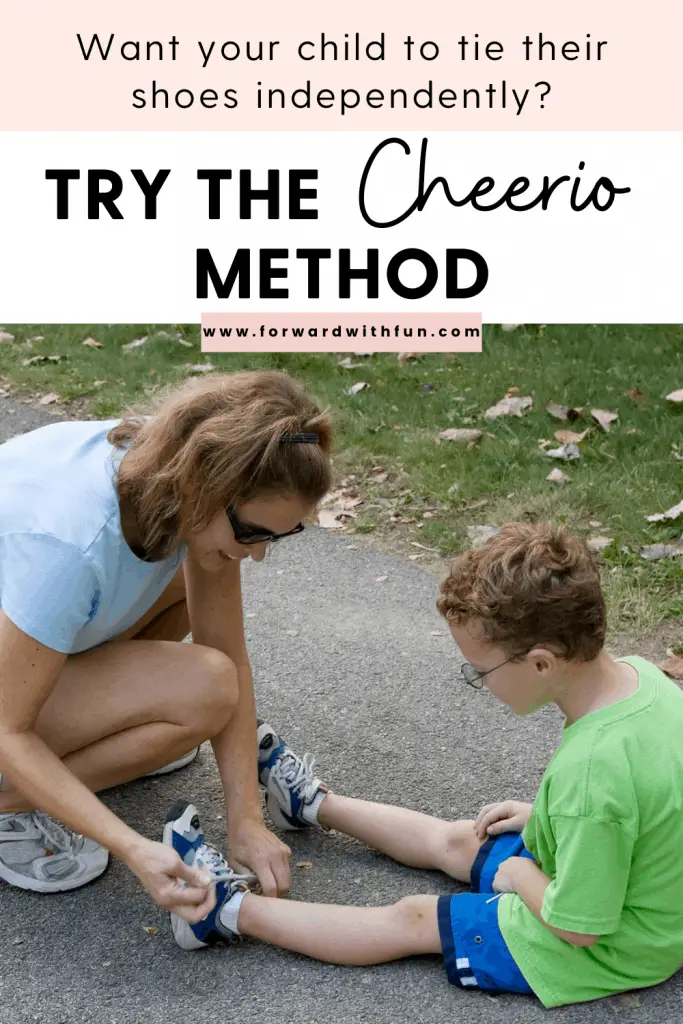
The Cheerio way will teach your child how to tie shoes in 5 easy steps, and it works! It breaks down the most difficult part into two simple steps that kids really understand and can take ownership of. This is true hands-on learning.
This method does make a slightly different knot. Just pull up on one of the loops and it'll undo itself, simple as pie!
Step 1-Take the two strings and cross them over. Now take one of them and put it through the hole and pull them tight.
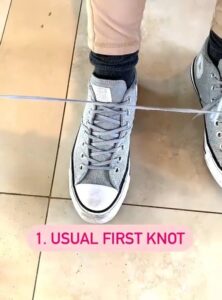
Step 2- This is the step that makes the biggest difference! Do the same thing again, but instead of pulling the strings all the way tight, I'm leave a little hole big enough for a Cheerio. (It can be bigger than a Cheerio, but Cheerio is a cute reminder for them).
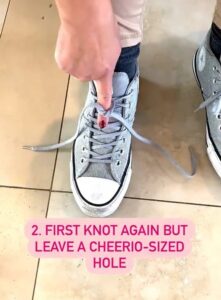
Step 3- Take one lace and put it through the Cheerio making a little loop. Don't pull it yet.
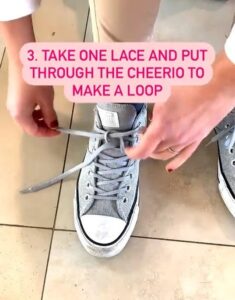
Step 4- Repeat on the other side.

Step 5- Pull both loops outward and the shoe is tied!

Generally kids learn to tie their shoes between the ages of 5-7. The real answer is that everyone learns at their own pace. Tying shoes takes practice and dexterity.
For children that struggle with fine motor skills, it may take longer. To learn more about how to build up fine motor skills, check out this article that includes many fun, hands-on activities that strengthen the small muscles in fingers, hands, and wrists required for children to manipulate shoelaces, buttons, zippers, and writing utensils.
Using The Cheerio Way, I've helped many children aged 4-5 years old learn to tie their shoes. It works better than the "Bunny loops" version that requires children to hold a knot with one hand and then pull a lace around that and through with the other hand by removing that part completely!
Usually kids master the first step and get stuck, but with the Cheerio Method of tying shoes, they feel more comfortable moving to the second step since it's basically just a repeat! This method is also more accessible to kids with limb or finger differences that may struggle with manipulating objects using both hands.
Again, this question doesn't have a solid answer. The best way to teach your child is the one that works for them. I would even try more than one method and see what clicks.
There is the bunny loop method, which is actually how I was taught. The saying for tying your shoes with the bunny ears method goes like this:
Over, under, around and through,
Meet Bunny Rabbit, pull and through.
Another option is the double bunny ears method. Instead of pulling the bunny around and through, you make two loops, cross them over one another, then pull one under and through.
To me, both the bunny loop and double bunny ears method require lots of coordination on the part of the child. Looking for fun and easy ways to increase your child's dexterity? Check out these mega-fun fine motor skills activities.
Just because they require more dexterity doesn't mean these are not great methods though! I actually had a MEGA-VIRAL pin about shoe-tying on Pinterest that has over 6.5 million impressions. It had lots of love and some truly grumpy comments from people who did NOT want to learn any way but their way of tying shoes. HAHA!
But in all seriousness, the Cheerio method of tying shoes is an excellent option for kids, but that's just what it is, an option. Choose whatever works for you!